
Alameda is a city in Alameda County, California, United States, located in the East Bay region of the Bay Area. The city is built on an informal archipelago in San Francisco Bay, consisting of Alameda Island, Bay Farm Island and Coast Guard Island, along with other smaller islands. As of the 2020 census, the city's population was 78,280.

In the United States, trolley parks, which started in the 19th century, were picnic and recreation areas along or at the ends of streetcar lines in most of the larger cities. These were precursors to amusement parks. Trolley parks were often created by the streetcar companies to give people a reason to use their services on weekends.

Knoebels Amusement Resort is a family-owned and operated amusement park, picnic grove, and campground in Elysburg, Pennsylvania. Opened in 1926, it is the United States's largest free-admission park. The park has more than 60 rides including three wooden roller coasters, three steel roller coasters, a 1913 carousel, and two haunted house dark rides.

Bay Beach is a municipal amusement park in Green Bay, Wisconsin. Situated near the mouth of the Fox River, on the east bank as it flows into Green Bay, the park contains rides, concessions, a roller coaster, and a food pavilion. Dances, movies, and other events are held in a pavilion. The park is adjacent to the Bay Beach Wildlife Sanctuary.
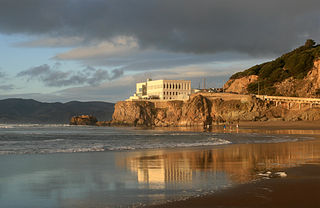
Ocean Beach is a beach on the west coast of San Francisco, California, United States, bordering the Pacific Ocean. It is adjacent to Golden Gate Park, the Richmond District, and the Sunset District. The Great Highway runs alongside the beach, and the Cliff House and the site of the former Sutro Baths sit at the northern end. The beach is a part of the Golden Gate National Recreation Area, which is administered by the National Park Service. It is accessible via Muni Metro at the Judah and La Playa station.
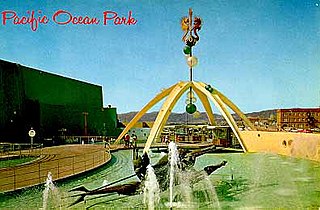
Pacific Ocean Park was a 28-acre (11-hectare) nautical-themed amusement park built on a pier at Pier Avenue in the Ocean Park section of Santa Monica, California in 1958. Intended to compete with Disneyland, it replaced Ocean Park Pier (1926–1956). After it closed and fell into disrepair, the park and pier anchored the Dogtown area of Santa Monica.

Popsicle is a Good Humor-Breyers brand of ice pop consisting of flavored, colored ice on a stick.
The Santa Cruz Beach Boardwalk is an oceanfront amusement park in Santa Cruz, California. Founded in 1907, it is California's oldest surviving amusement park and one of the few seaside parks on the West Coast of the United States.

Idora Park was a 17.5-acre (71,000 m2) Victorian era trolley park in north Oakland, California constructed in 1904 on the site of an informal park setting called Ayala Park on the north banks of Temescal Creek. It was leased by the Ingersoll Pleasure and Amusement Park Company that ran several Eastern pleasure parks. What began as a pleasure ground in a rural setting for Sunday picnics evolved into a complete amusement park visited by many residents of the San Francisco Bay Area. Its popularity declined after the advent of the automobile, and it was closed and demolished in 1929.

Jantzen Beach Amusement Park was a popular amusement park from 1928 to 1970 in Portland, Oregon, on Hayden Island in the middle of the Columbia River. "The Coney Island of the West" opened on May 26, 1928 as the largest amusement park in the nation, covering over 123 acres (50 ha) at the northern tip of Portland.

Pacific Park is an oceanfront amusement park located in Santa Monica, California. The park, located on the Santa Monica Pier, looks directly out on the Pacific Ocean, in the direction of Catalina Island. It is the only amusement park directly located on the West Coast of the United States located on a pier and LA's only admission-free park. There are a total of thirteen rides in Pacific Park, including the world's first and only solar-powered ferris wheel that provides a view of the Pacific Ocean and a roller coaster that circles the majority of the park. Pacific Park is also home to 14 midway games and over-the-ocean food and retail outlets. It has appeared in over 500 movies and television shows such as Fat Albert, Hannah Montana, Hannah Montana: The Movie, Kidsongs, 90210, Bean, and The Tonight Show with Jay Leno, as well as the popular video game Grand Theft Auto V. In 2020, it featured in the opening ident for the sky television channel Sky Comedy. It is operated by Premier Parks LLC.
The Pike was an amusement zone in Long Beach, California. The Pike was founded in 1902 along the shoreline south of Ocean Boulevard with several independent arcades, food stands, gift shops, a variety of rides and a grand bath house. It was most noted for the Cyclone Racer (1930–1968), a large wooden dual-track roller coaster, built out on pilings over the water.

Playland was a 10-acre (40,000-square-meter) seaside amusement park located next to Ocean Beach, in the Richmond District at the western edge of San Francisco, California, along Great Highway, bounded by Balboa and Fulton streets. It began as a collection of amusement rides and concessions in the late 19th century, and was preceded by Chutes at the Beach, opened in 1921. Playland closed Labor Day weekend in 1972.

Charles I. D. Looff was a Danish master carver and builder of hand-carved carousels and amusement rides, who immigrated to the United States of America in 1870. Looff built the first carousel at Coney Island in 1876. During his lifetime, he built over 40 carousels, several amusements parks, numerous roller coasters and Ferris wheels, and built California's famous Santa Monica Pier. He became famous for creating the unique Coney Island style of carousel carving.
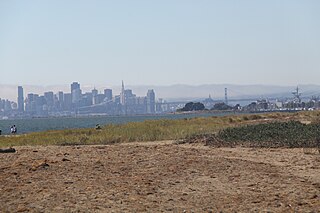
Crown Memorial State Beach is a state park in the city of Alameda, California on the shores of San Francisco Bay. It is operated by East Bay Regional Parks District (EBRPD), under a cooperative agreement with the State of California and the City of Alameda.

Santa Cruz Looff Carousel and Roller Coaster On The Beach Boardwalk is a National Historic Landmark composed of two parts, a Looff carousel and the Giant Dipper wooden roller coaster, at the Santa Cruz Beach Boardwalk in Santa Cruz, California, United States. They are among the oldest surviving beachfront amusement park attractions on the west coast of the United States. They were listed as a pair as a National Historic Landmark in 1987.
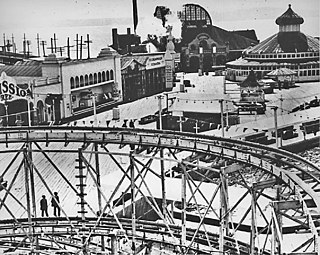
Luna Park was an amusement park in Seattle, Washington that operated from 1907 until 1913. Designed by famed carousel carver Charles I. D. Looff, who carved and installed Coney Island's very first carousel, Luna Park took its name from Coney Island's Luna Park. On July 4, 1908, Luna Park became the site of Seattle's first manned flight.
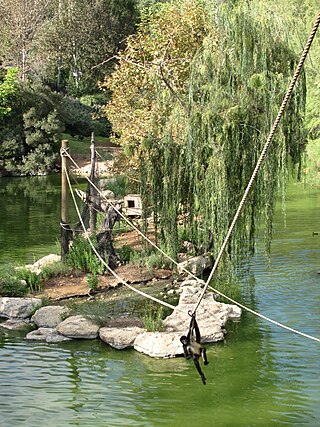
An animal theme park, also known as a zoological theme park, is a combination of an amusement park and a zoo, mainly for entertainment, amusement, and commercial purposes. Many animal theme parks combine classic theme park elements, such as themed entertainment and amusement rides, with classic zoo elements such as live animals confined within enclosures for display. Many times, live animals are utilized and featured as part of amusement rides and attractions found at animal theme parks.
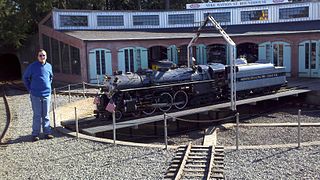
The Sonoma TrainTown Railroad is a tourist railroad and 10 acre amusement park in Sonoma, California. Its logo is based on the logo for the New York Central Railroad. Its main feature is a 15 in gauge miniature railway, which closely corresponds to a 1:4 scale model of a 4 ft 8+1⁄2 in standard gauge railroad.

Casa del Rey Hotel was a resort hotel in Santa Cruz, California. During World War II the hotel was converted to the Naval Convalescent Hospital, Santa Cruz. The hotel was built in 1911 by Fred Swanton on Beach Street as a Santa Cruz Boardwalk development plan. The Resort Hotel had: a pool; gardens; and a grand pedestrian bridge to cross the street to visit the beach. The hotel was at about 500 Beach Street and Cliff Street. In addition to the hotel, there were built Cottage apartments. Later after the war the hotel became a senior citizen housing. In the 1989 Loma Prieta earthquake there was serious damage to the hotel and was taken down. The site now is the parking lot across the street from the Santa Cruz Beach Boardwalk amusement park.




















